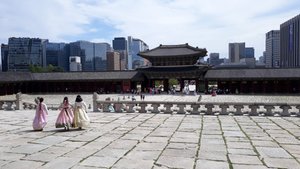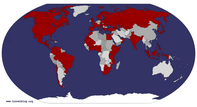Advertisement
Published: October 5th 2018

 Gyeongboggung Palace, Seoul
Gyeongboggung Palace, Seoul
It seems to be a common weekend activity for teens and early-20s Koreans to dress up in traditional attire and tour the historical sites of Seoul.I’ve had a fair few friends who have lived in South Korea and all recommended it. But it never seems to be as desirable a place to visit as most other countries in the region. That can’t be only true for me as we saw few foreign tourists during our two weeks in the country. Some nearby countries have their big sights that lure people in, such as Thailand’s or the Philippines’ beaches and Cambodia’s got Angkor Wat. I think other countries are appealing if they have a unique culture that is highly visible in the media, such as Japan. Maybe Vietnam is popular because everyone knows about it from the war and from watching famous war films and they want to go and see it for themselves. So why isn’t South Korea more popular? Despite having a lot of impressive places to visit, it has no real mind-blowing sights. Perhaps Korean culture, food, fashion is not too well-known; that’s certainly true in Europe (at least before “Gangnam Style”). Is it fear because it’s so close to North Korea? Or do people struggle to sub-consciously separate the two Koreas? Is it because it’s not on any overland backpacking routes (explaining why

 Noryangjin Fish Market, Seoul
Noryangjin Fish Market, Seoul
A very big, very delicious and very expensive snow crab, bought on the ground floor market then cooked upstairs.people end up going to Laos)? I can’t provide an answer, but I do think it needs a better tourism marketing department because South Korea is great.
A conference brought me to South Korea – the same conference that took me to Croatia last year and may take me to Spain next year and Brazil in 2020. The International Association of Hydrogeologists certainly do know how to pick venues. As soon as the conference venue was announced and registration was open I booked it. When else would I ever visit? Clearly it would be a shame to fly all that way, paid for out of the last dregs of my PhD budget just before I finished, without having a look around. Thus, we went for two weeks with the first week to see some of the country and the second based in Daejeon for the conference.
First stop Seoul. I’m not generally a city person but Seoul was great. Easy and cheap to get around, a lot to see, and a lot to eat. Even though the public transport is very good, we walked between many places to see the bits in between. This

 7th century carved Buddhas and resident monk at Chilbulam Hermitage, Gyeongju
7th century carved Buddhas and resident monk at Chilbulam Hermitage, Gyeongju
The hermit monk invited us in for tea, sugary snacks, and strange cheese in a tube while we had a conversation through google translate on his iphone.led to us stumbling across even more great street food, more futuristic buildings and some interesting festivals and events. Walking about is made easier by the pedestrianised and gardenised former road flyovers and daylighted streams. Rather than being dodgy places to walk, these urban streams are lined with trees, art, and light shows. Seoul’s palaces are pretty though do get a bit samey, the markets are great and the variety of foods within do not get samey at all. I’m not sure we ate the same food twice in two weeks.
Getting anywhere else is also very easy as trains do 300 kph, they are on time, and they are reasonably priced – even when you buy a ticket just before boarding. And then in that new city, your public transport pass from Seoul still works on every piece of public transport there too. How civilised and how obvious.
South Korea manages to squeeze in 12 UNESCO World Heritage Sites despite being a country only about the size of Hungary (8 sites) or Indiana (no sites). Without intending to – we just chose nice places to visit – we managed to go to one UNESCO site

 Kwangjang Market, Seoul
Kwangjang Market, Seoul
Enjoying the food here while waiting for the compulsory guided tour of the nearby UNESCO recognised Jongmyo Shrine was probably the highlight of the trip to Jongmyo Shrine.a day for the first six days of the trip:
Day 1. Changdeokgung Palace, Seoul: worth it though we couldn’t work out why the equally historic and pretty nearby Gyeongbokgung Palace is not on the UNESCO list.
Day 2. Jongmyo Shrine, Seoul: unfortunately, you have to take a guided tour so go around in a large group being fed highly detailed information while having no time to sit and absorb the place. I’d recommend trying to visit when a festival is on.
Day 3. Bulguksa Temple and Seokguram Grotto, Gyeongju: the temple was probably our favourite temple/palace that we visited as it actually seemed old. Many others have been renovated/rebuilt very recently. Seokguram Grotto is a quick visit that is impressive due to the age and perfection of the carved granite Buddha. The hike up the hill between the two sites is a hot sticky one with lots of chipmunks for company.
Day 4. Gyeongju Historic Areas: the city contains a lot of royal burial tombs and ruins though the highlight was hiking up and around Mount Namsan. As well as being a pretty though strenuous hike with great views, around many corners are more tombs,

 Bulguksa Temple
Bulguksa Temple
Originally constructed in the 8th century but destroyed and rebuilt a few times ever since.ruined temples, statues and stone pagodas.
Day 5. Haeinsa Temple, Daegu: it is UNESCO recognised as it houses the Korean Tripitaka; 81,350 wooden blocks on which are carved all the Buddhist Scriptures. Whereas most of Korea’s other wooden palaces and temples have suffered numerous fires and rebuilding in the past (as has Haeinsa Temple itself), the Janggyeong Panjeon depository has survived them all unscathed. The construction was carefully designed in the 1400s to take advantage of prevailing winds and shade, while incorporating clays in the roof with charcoal and salts in the floor, all in order to maintain a temperature and humidity that would not lead to degradation of the wooden blocks. A modern facility constructed in the 1970s with all available atmosphere-controlling technology was found to mildew test blocks quite quickly and the planned transfer of all 81,350 blocks from the old facility was scrapped. There isn’t actually too much to see here. And the hike up the mountains in Gayasan National Park at the back is through thick forest so you could be anywhere. Only when you pop out on the peak do you get great views.
Day 6: Hahoe Historic Village, Andong: different to the
other historic villages in that this one is still lived in so not just for show. It only takes an hour or so to walk around but it’s worth going for the mask dance.
It took until day 7 to not go to a UNESCO site and that day we went hiking in Juwangsan National Park, which could have been the prettiest place we visited on the whole trip. Though we went on a weekend, which is when seemingly all of Korea likes to go hiking. And they all like to be fully North Faced up despite only walking 5 km from the car and back again on tarmac paths with occasional well-constructed wooden steps. Though most of Korea’s national parks are so small that in a single day you can walk pretty much the whole park. There aren’t large networks or paths, rather just a few well-marked and well-maintained trails with handy maps on signboards every kilometre.
Day 8: Gongju (Baekje Historic Area), Daejeon: pretty but only worth going to if you are nearby (e.g. in Daejeon for a conference). The fort is completely rebuilt though the original apparently would have been wood and earth whereas as
this new one is stone. How this qualifies for UNESCO I don’t know; is it so easy just by building something not necessarily in the same style as the historic original as long as it’s in its approximate location?
Day 14: Hwaseong Fortress, Suwon: we liked this one. Maybe because after five days spending all day sitting in front of conference presentations in a modern convention centre it was nice to stroll around the 6 km of walls. Add it your list of walled city walls to circumnavigate (along with York, Dubrovnik, Jerusalem, Carcassonne, Jaisalmer, San Gimignano, Lugo, Mdina, Harar, Galle, and that’s all that spring to mind that I’ve visited. Anymore?).
I’ll finish off by saying that South Korea seems about 20 years into the future. But it’s a future that I fear the UK (most of Europe? Probably not Scandinavia as that is already way ahead) will ever reach. I used to notice when I travelled how many years behind the UK many countries were in terms of development, sophistication and common sense. However, Britain has being going backwards over the last ten years or so and most of those other countries have caught
up. Here are some examples of why South Korea is 20 years ahead:
• Wifi is everywhere, free and open
• Public toilets are everywhere, even up mountains, and are always spotless
• Everything everywhere can be paid for by card
• Public transport is cheap, clean and efficient
• The food is very healthy – it’s rare to see anyone overweight
• Public spaces (parks, gardens, sports facilities, etc) are abundant, well-maintained and well-utilised
• The cities have plenty of cycle paths on the pavements rather than on the roads
• National Parks and historic places are clearly well-funded, well-managed and well-visited
• Footpaths in national parks have recycled tyres on the steep bits and steps to give you more grip in the wet
• Where you do have to pay entry to some historic sight, it is generally under £1 and there are no differences in local and foreigner prices
• Talking to some of the Korean professors at the conference; the government currently want to attract more international researchers to Korea and they want Korea to be more visible internationally, consequently they are pouring a lot of money into research
• We saw a few homeless people at Seoul Central Station but nowhere else so clearly the
welfare system works
• Roads are pothole free, pavements are level and are kept clean; not that we ever saw any litter anyway
• There can’t be much crime as there are lots of people, male or female, walking around alone in dark parts of cities in the early hours
• Similarly, there can’t be much pointless vandalism as there are unscathed large screen LED TVs that hang just above pedestrianised streets (close enough to the ground to whack with something if you wanted to) playing 24-hour news or K-pop videos
• There generally seems to be respect for each other and for the place, explaining the previous few points.
South Korea was never high on my list of places to visit. It should have been.
Advertisement
Tot: 0.062s; Tpl: 0.019s; cc: 11; qc: 23; dbt: 0.0353s; 1; m:domysql w:travelblog (10.17.0.13); sld: 1;
; mem: 1.1mb























